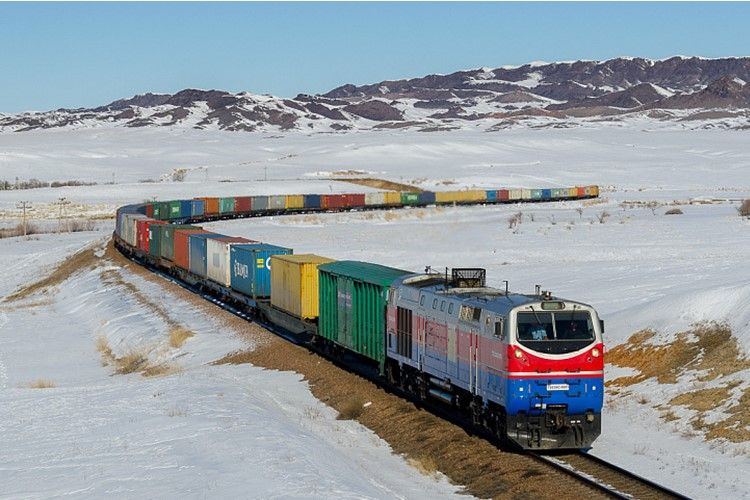“Here is an idea. Why not make the Middle Corridor a humanitarian corridor to transport essential goods such as food, energy, health (medical, pharmaceuticals etc)? These goods are always and critically needed, and the Middle Corridor will be less subject to geopolitical tension.”

Photo credit: railways.kz.
It is one of the suggestions by Leila Batyrbekova, founder of ECATA – Europe and Central Asia Transport and Trade Association. “Regular transit cargo could be transported via the main corridor, of course when sanctions are not an issue.” The transport of essential goods should be guaranteed, and this corridor will be less of a risk, she argues.
Another idea

Majorie van Leijen
An international logistics expert from Kazakhstan, she will talk about the Middle Corridor at the European Silk Road Summit in Budapest, which takes place from Nov. 29 to Dec.1 this week. As one of the first to promote the Middle Corridor within the community, she has seen the route change and adapt to the complex geopolitical circumstances. Maybe that is why she is adept at finding new impetus for the corridor as well.
“Another idea: Why don’t we use the Middle Corridor for imports and exports of Kazakhstan, whose main trading partner is the European Union, as well as the growing Central Asian region as a whole?” she says. “This year, Kazakhstan increased oil exports to the EU through the Middle Corridor, as it did in the 2000s,” she adds.
This proposition makes sense if you consider that the volumes of transit traffic via the Middle Corridor decreased in the first ten months of this year. On the contrary, import and export traffic from the region increased on the corridor. Transit cargo on the main route via Kazakhstan also increased.
Geopolitical shifts
These figures can be understood in the context of a changing understanding of what the Eurasian community entails. Since the start of the war in Ukraine, rail transport between China and Europe dropped significantly, as European companies were reluctant to transit cargo through Russia. Rail transport between China and Russia increased, and the European Union started to look at Central Asia as the region of resources.
In June, the European Commission presented the Global Gateway strategy, offering a solid basis for major potential investments in sustainable transport connections between the EU and Central Asia. “If all these proposed action items and projects are implemented, the Central Trans-Caspian network could ensure a predictable transit time of 13 days. I look forward to bringing Europe and Central Asia closer together through sustainable transport links,” said an enthusiastic Commissioner for Transport, Adina Vălean at the time.
Welcome investments, but for how long?
The increased attention of the EU in the Middle Corridor is welcome news for the corridor, which still has an intensive infrastructure upgrade programme ahead. At the same time, the political enthusiasm is not shared very much by the market, Batyrbekova acknowledges. “The reputation of the Middle Corridor is still being built. While many companies are happy, some suspect long transit times and stay away.”
At the same time, one needs to wonder for how long this optimism remains. “We cannot be sure if the same interest in the Middle Corridor remains when the war is over. We already saw companies returning to the Northern Corridor since the end of 2022 and more may follow after the war,” Batyrbekova says.
“In order to grow and maintain optimism by the private sector we need to work on enhancing the capacity of the Middle Corridor. What we need are long-term investments, not only in the field of transport, but also new joint projects and businesses between companies from Europe and Central Asia for a continuing long perspective. This part of the challenge can be solved by joint and concrete actions. Investments first want to see a clear and strongly united approach by the stakeholders of the corridor.”
China’s role
Equally important is the role for China to play in this. As of late, China increased its interest in the corridor with promises of major investments in the region. Batyrbekova explains “China has always been interested in the Middle Corridor; earlier there were also some transit subsidies on part of the corridor.”
“However, in the past, it has not highlighted this support because the northern corridor was easier to focus on. The fact that it has decided to promote the Middle Corridor may potentially lead to actual commitments from Chinese investors. It has given impetus to Chinese businesses to consider using the Middle Corridor.”
A vision from Kazakhstan is important
Although she is more than welcoming this impetus, logistics professionals believe that in the end, it should be Kazakhstan that takes a stance on the level of priority of the Middle Corridor. The Middle Corridor runs through its territory and in the end, Kazakhstan will remain on this and other corridors in any case.
“What is really important in my opinion, is a strong message to the transport world coming from Kazakhstan. All attention is turned to the newly created Ministry of Transport of Kazakhstan. What kind of innovations and developments in this regard will occur in the transport industry of Kazakhstan as a whole and how will this be done, taking into account the many transport corridors passing through Kazakhstan and influencing the market?” Batyrbekova wonders.
“Transport and logistics companies will be happy to share their suggestions and recommendations for improving the work of the corridor with the new ministry. Interaction in a new format – a platform- can be useful and unite stakeholders from different countries, institutions, international organizations and direct clients of the Middle Corridor.”
The article was originally published in RailFreight.com.
Disclaimer: The views and opinions expressed in this article are those of the author and do not necessarily reflect the position of The Astana Times.


